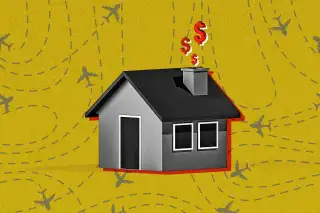Say What? This Surprising Factor Could Hurt Your Home's Sale Price

If you live close to an airport, the roar of passing jets is more than just a noisy nuisance — it could be quietly eating away at your home's value.
A working paper published this week by the National Bureau of Economic Research looked into the impact of noise pollution on home prices in neighborhoods located close to major airports. It found that a one-decibel increase in noise levels results in prices falling by 0.6% to 1%.
That may not seem like a lot, but consider that modern commercial aircraft — which are purposely designed to reduce noise — generate between 75 and 80 decibels of additional noise during landing, with higher levels during takeoffs. Major airports can see thousands of planes taking off and landing every day, so the frustration factor (and the price hit) can be pretty high.
According to Stephanie Crawford, a real estate agent and founder of the Brokers Cooperative in Nashville, Tennessee, noise pollution can reduce home prices by 10% to 20% for homes located within three miles of an airport. Considering that the nationwide median home price is about $415,000, the loss of value can be significant.
The uproar over the noise has led to a series of lawsuits against the Federal Aviation Administration, or FAA, especially after the government agency changed flight paths in 2013. The new routes concentrated more traffic into narrower lanes, producing higher and more frequent flyovers.
In 2015, homeowners in Phoenix sued the FAA over increased noise pollution, eventually winning the case and leading to a return to the previous takeoff and landing routes. A similar lawsuit was filed by the state of Maryland in 2017. Earlier this year, two townships in New York state sued the FAA, alleging excessive noise and pollution from the John F. Kennedy and LaGuardia Airports.
Why location still rules — even when close to an airport
In a housing market where concerns over affordability and a lack of significant buyer interest are leading sellers to cut prices, the last thing a homeowner needs is another reason their home might not be worth as much as they hope.
As with everything real estate, location is key. The exact impact on prices will depend on where your home is located in relation to flight paths, or the routes planes take when taking off or landing.
"The biggest factor isn't how close you are to the runway," says Crawford, who actually lives in a flight path. "It's whether you're directly under approach routes, where planes are lower and louder."
This means not everyone residing next to a busy travel hub will be negatively affected. Homes near airports and not directly under the primary flight paths will have less noise pollution and could even be attractive to prospective buyers who are also frequent travelers, mitigating any potential loss in value or even leading to higher home prices.
But Nathan Richardson, founder of the digital real estate platform CashForHome.com, says he has noticed that listings near busy airports often attract less buyer attention, take longer to sell and involve more price negotiations.
How prospective buyers view these properties affects more than just price, Richardson adds. People tend to link homes near busy airports with greater stress, poorer sleep patterns and higher levels of air pollution, even though the data on how high noise levels actually affect people's mental health is mixed.
"Once that stigma exists in a neighborhood, it's hard to reverse," Richardson says.
More from Money:
8 Best Mortgage Lenders of 2025
Mortgage Rates Below 6%? Don't Hold Your Breath
The End of a Century-Old Trade Rule Is Set to Cause Holiday Mayhem